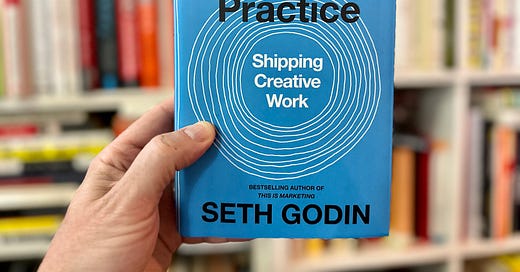036: It's time to start shipping the future
[Before - Session 12] Getting sharp for Assignment #1 - Sell Something New
Tomorrow we’re going to begin creating ideas.
We’ve spent the previous 11 weeks of The Future of Advertising talking about history, strategy, process, and major themes including augmented reality, social media, efficacy, and commerce among so many others. In other words, people who generate ideas in 2023 have a robust library/tool shed from which to draw inspiration. Just imagine (only 30 years ago) before the third pivot, most advertising was limited to words and images in printed things and you could add sound and motion to broadcast. But that was it.
Now our palette is very wide. A blessing and a curse.
Assignment #1 (of 3) is to Sell Something New.
In our case, the new thing is a retail practice sitting on top of two ancient traditions, and an illuminating statistic.
Ancient Tradition 1 = Professional knife sharpening
Ancient (well, old enough) Tradition 2 = The U.S. Mail
Statistic: According to research from manufacturer Zwilling Henckles, 90% of kitchen knives have never been professionally sharpened. 😮
So the new thing is convincing the 90% of people who have never had their knives professionally sharpened, to do so—via the U.S. Mail.
The business is called Vivront. Founder
has been chronicling his start up journey here on Substack. I’m fascinated with the behavioral economics behind this industry. (To be clear, Vivront isn't the first to try and take advantage of the statistic + the Internet.) There's a wealth of uncertainty and hesitation in this space, and also massive oppportunity. It will be exciting to see how the students translate the assignment and respond with ideas.I’ll share the brief and in-class reactions in tomorrow’s “During” post.
I’m half way through Seth Godin’s latest book. As usual, it’s full of useful, actionable wisdom. I’m underlining, bracketing and writing notes to myself in the margins. As in so much of Godin’s writing since Linchpin, the focus here is first to recognize a distinction: Creative work is rarely industrial work. What industrialized culture actually celebrates is conformity, consistency, and certainty—not change. [BTW, this is not a judgement of industrial work, merely an important distinction. Industrial work matters; it’s just typically not creative work.]
So, to ship creative work is to operate apart from much of accepted, “proven,” outcome-worshiping methodology. This is particularly difficult because guess who’s on the hook? Especially if the end result isn’t…well, isn’t whatever might have been expected or proposed originally. Godin explains:
“Creativity is a skill, not a talent. It can be learned. If we trust our selves, we can do more than we ever imagined.”
So the business of creativity is perhaps first about, “trusting yourself enough to be the kind of person who engages in the process of delivering creative work.” Because, “the professional understands the fine line between showing up with a generous vision and showing up trying to control the outcome.”
If creativity were easy, everyone would just do it.
And that’s why you and I are here, sharing words. Trying to make it a little bit easier to create the change we seek.
See you tomorrow.





We're looking forward to the exercise Tim + team!